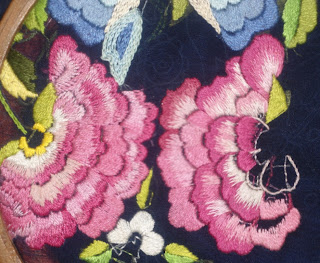Exploring Long and Short Stitch Variations in My Neck Design
This is my progress so far on the neck design! I’ve been slowly bringing the floral motifs to life, and as you can see, the two large pink flowers are finally taking shape. Each time I sit down to work on this piece, I’m reminded why I love embroidery so much — every single stitch adds dimension, personality, and a story of its own.
Now, if you take a closer look at the two flowers, you might notice a subtle difference between them. Can you spot it? Both are worked in long and short shading, but the technique I used for each flower is slightly different — and that small variation has created two very distinct visual effects.
It’s fascinating how such a small change in stitching technique can make such a big difference in the final outcome. The first flower appears more structured and crisp, while the second looks softer and fuller. Both have their own charm, and together, they add richness and variation to the overall design.
Working on this neck design has been a wonderful exercise in patience and observation. Sometimes, I find that experimenting on the same motif — using slightly different methods — teaches me more than following a fixed pattern ever could. Each stitch becomes a little experiment, a chance to understand how thread, tension, and direction interact with light and fabric.
I’m still working my way through the rest of the piece. The leaves and smaller flowers are next, and I’m planning to continue experimenting with stitch variations to see how they influence the overall look. I’ll be sure to share more progress soon — hopefully with both of these pink blossoms fully completed and glowing against the dark background fabric.
Have you ever tried using two different methods for long and short stitch in the same project? I’d love to hear about your experience and which effect you prefer — the smooth precision of the first, or the soft blending of the second!




